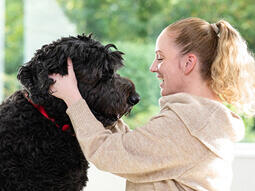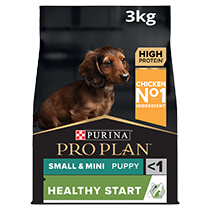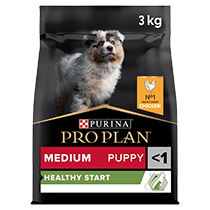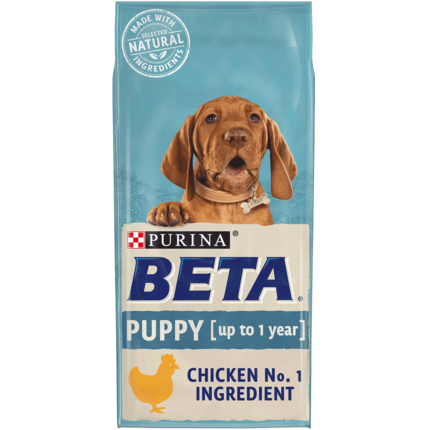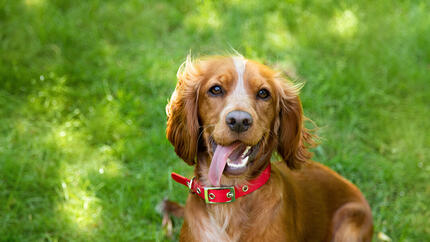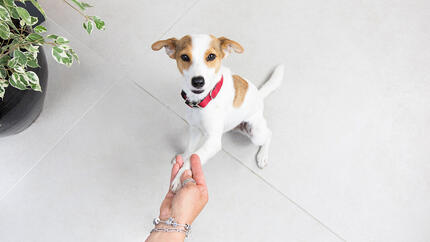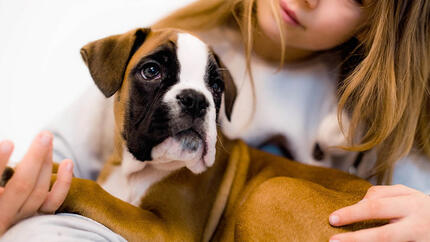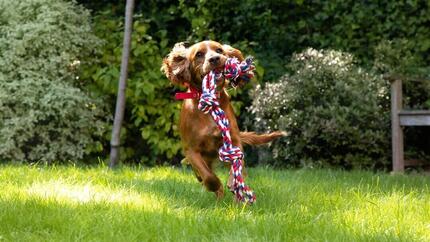

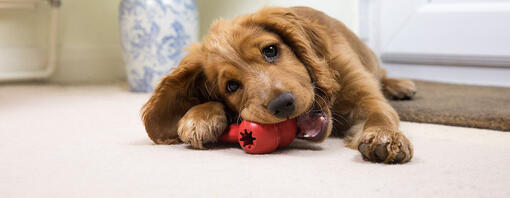
Playing with your puppy is a huge part of your relationship, and it has loads of benefits! The couple who play together, stay together – and play will build the bond and the trust between you – and give you ways to interact and enjoy your time together.
Puppy games help keep your playful bundle of energy active and healthy, help in their physical development, and build their confidence and problem-solving abilities. So, if you want to know what some of the best games to play with your puppy indoors are, then you’ve come to the right place, carry on reading to find out all you need to know about puppy games.
Types of Games to Play With Your Puppy
People often think that the only exercise a dog needs is a daily walk – but that couldn’t be further from the truth. A walk exercises their body, gives them a change to explore the great outdoors, investigate new smells and meet new people (canine and human) and gives them a much needed change of scenery from being stuck in the house all day.
Play and games however gives them an appropriate outlet for some of their hardwired instincts (such as chewing, gnawing, chasing, catching…), provides enrichment opportunities, teaches them problem-solving skills, builds confidence – and possibly more importantly, builds the bond they have with you.
Sometimes playing games in the house mixed with some training exercises can be an alternative to a walk if the weather is truly awful – or for some reason you or your dog can’t go outside. And of course these will be invaluable with your baby puppy until they are old enough (fully vaccinated) to go out into the great outdoors.
Owners who play with their dog usually have a far better relationship with the canine that shared their life and their home – and they certainly have more fun! So read on for some ideas of games that you can both enjoy.
First games
For a young puppy, games need to be gentle, calm and safe. The idea of these games is to build their confidence and teach them that you are a great person to play with. Up till now, their only playmates have been other dogs and this is a time to learn that you are fun too!
In our enthusiasm, it’s easy to overwhelm a young puppy with overly active games and so start with quiet games that teach lifeskills – but are still fun!
Climbing frame
A great early game to play with your baby puppy is just lying down on the floor and let them climb over you and explore you. Don’t use any hands and don't do anything else but let them walk over you, stand on you, roll around… This is fun for you both but it gives your puppy a chance to get to know you without any forced interactions. In turn you get to discover a lot about your new arrival – are the confident, totally gung-ho, or more thoughtful, Do they explore with noses, paws or teeth. This is a voyage of discovery for you both!
You can add in some tasty treats every now and then too – so they learn just how fabulous you are.
If they start to get overexcited however, it’s time to quietly stand up and end the game.
Sniffing games
Playing sniffing games with your puppy might be the very best thing you can do with them – and it’s something so many owners overlook.
These are games that provide great enrichment but they are good games for calming down an over-bouncy pup – and distract from jumping, grabbing and nipping.
These can be anything from following a trail of treats, to scrunching up an old towel on the floor and hiding some treats in the folds, to putting treats into an old kitchen roll tube for them to sniff out and discover how to get out.
There are shop made toys too like snuffle mats – which do the same thing (but if you are a bit handy, you can make them yourself).
For older puppies
Tuggie
If your puppy is still learning what they can and can’t chew and loves grabbing things and pulling, redirecting onto an appropriate toy with a fun but gentle puppy game of tuggy can be the perfect deflection.
Plus, some breeds really love these games - especially terriers - as it taps into their natural instincts to grab and pull. For some however it can be a bit intimidating so you have to make sure it is them that is tugging and not you – and if they don’t, then that is fine.
Make sure you have a toy that’s long enough for you to both hold comfortably without their teeth accidentally being able to come into contact with your fingers.
Always let your puppy lead the tug – they pull you and NOT the other way round. All you do is hold the toy steady and provide resistance.
While it is tempting, pulling too hard can damage or be painful on baby joints and muscles, and it can also lead to your puppy losing confidence.
Never drag them around and make sure you don’t pull the toy upwards instead you can wriggle the toy from side to side, but always let them tug you.
Ignore the old- fashioned advice of ‘never letting your puppy win’ a tug of war game. Take it in turns to end up with the toy. This is a partnership not a dictatorship – and who would want to play a game where you can never win. Your puppy’s confidence and development will benefit from successes.
If your puppy is getting really over-excited and starts grabbing or biting, stop the game by swapping the toy for a treat.
This game can be tiring, especially for puppies, so don’t play it for too long - and never play this on a slippery floor.
Hide and seek
This is a great option from our puppy games list. Hide and seek builds confidence, helps start teaching recall (or improves it) as your puppy learns that coming to you is rewarding and fun and it is a fun game that all the family can play.
Some dogs who don’t like more interactive games like chasing balls or tugging things, love to play hide and seek.
Ask someone to hold your puppy while you hide somewhere in the room (or the next room) - behind a curtain, behind a door or behind a piece of furniture – with a tasty treat ready to reward them.
When you’ve hidden, call your puppy’s name and let them seek you out. When they find you, be really happy and excited, and give them a treat.
You can play this game inside or outside, making it a great choice whether you’re having an outdoors adventure or are stuck inside on a rainy day.
Retrieve games
Once you are out and about with your puppy, you can make your walking routine more fun by introducing some games – and for many dogs, retrieve games are ideal.
There are plenty of possible retrieve toys, from balls to Kongs to ropes – just find something that is safe, that won’t hurt their teeth – and won’t injure them (or anyone else if your throwing isn’t great!
This puppy game can help to make walks more exciting and interactive – as you are working together, as well as satisfying some of their hardwired instincts too (especially for retrieving breeds)!
While these games can be good fun, they should be played with caution. The repetitive nature of these activities, coupled with sudden starts, stops and turns, can cause injuries and lasting damage – and in a young puppy, this is increasingly likely. Plus there is also a danger of turning your dog into a ‘ball addict’ who will ignore you and everything else in favour of chasing their ball.
Only do a couple of retrieves at a time – and for puppies, these should be short distances only.
Some breeds however see no point in these kind of games – so it is a case of knowing your own dog and what they enjoy.
Obstacle course
These are games you can play with puppies of every age – as they are fun and help build confidence as part of your puppy’s socialisation and habituation programme.
You can create a fun and exciting obstacle course from household items and guide them through it, luring and rewarding with treats to make it fun all the way round. These can start off with tunnels made of cardboard boxes, or walking over uneven surfaces. You can buy tunnels that your dog can learn to go through, and you can even lure them round chailr legs – or your own legs!
All kinds of things can make a good obstacle – although always remember your puppy shouldn’t be jumping under a year old.
There are loads of things in your house that you can use to create a great obstacle course for your puppy. Your obstacle course could include chairs for them to run under, tunnels for them to go through, different surfaces to walk over, poles on the ground to step over, low cardboard boxes to climb on… Your imagination is the limit as long as it is safe and not scary.
Use plenty of treats as a reward for each obstacle and make sure you are both having fun.
These obstacles will help your puppy develop their co-ordination skills, as well as giving them some mental stimulation.
Dog tricks
Once your puppy is a bit older and has mastered all the training exercises teaching some fun and maybe even develop your bond and keep learning together. These tricks can be anything from giving a paw, to High 5, to play dead… to retrieving items or even putting things in the bin for you.
What do dogs like to play with?
There are no specific toy requirements when it comes to puppy games – it is all down to individual preference. Their breed or type might give you some clues – as does whether they are mouth-oriented or paw-oriented when they play but every dog is an individual and you will learn best through trial and error.
You’ll be able to tell your dog’s favourites by putting them all out and see which one they regularly go for when they get excited and playful, or do they have a favourite they like to lie down quietly with.
Try to note these behaviours down so you can choose the best toys and play the games your puppy enjoys rather than the ones you think they should enjoy!
Teaching your puppy to play
Whether you have picked your puppy up from a breeder or they have come from a rescue centre and you don’t know their history there is always the possibility that as they grow up, they won’t have any idea how to play with toys - or won't understand how to play with certain toys. This might be because they are used to playing with other dogs and not humans, or they have never had toys (or toys of a certain type) and might not have been introduced to the idea of play before.
Let them explore and investigate the toy first before starting any game. Let them sniff it and investigate it in their own time.
If it is something that squeaks, squeak it as quietly as you can behind your back first – so the noise doesn’t come as a scary surprise.
Once they have seen it and sniffed it, you can begin to slowly ‘bring it to life’ by wiggling it or rolling it so your puppy can get the idea that it’s fun and something to interact with. Soon there will be no stopping them!
If you find your dog doesn’t show any interest in stuffed or squeaky toys, try with toys you can put food or treats into. These toys combine fun with reward, as your dog will soon learn that when they push, pull or gnaw at the toy a treat can fall out, they will be rewarded for their efforts.
This is a great enrichment exercise that exercises your dog’s natural instincts and their need to achieve successes.
Sometimes this can be a good alternative way to feed your puppy rather than just putting food in their bowl – especially if it has been a day when you might not have given them all the exercise you usually do.
Benefits of playing games with puppies
Your puppy is growing fast, and in between napping, they’ll want to interact with you and that should include a lot of play!
As well as being fun, playing games with your puppy will build their confidence, improve their coordination, help their physical and mental development, and provide enrichment, and exercise their problem-solving skills. Best of all, it is the best possible bonding exercise for you both, as you’ll learn more about each other's personality and form a trust between you.
The most important thing is to have fun! The more time you spend playing together and bonding while your puppy is young, the better relationship you’ll have as they grow older.
Next, discover five easy tricks you can teach your dog.

